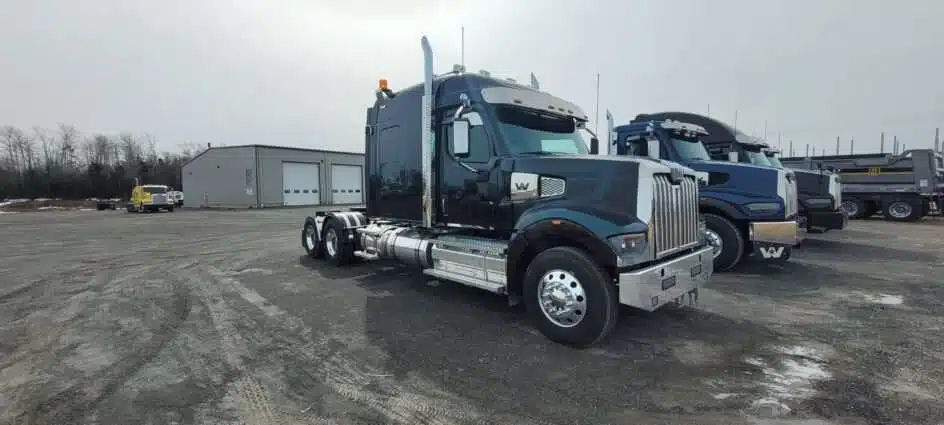
How Much Weight Can A Semi Truck Pull
A semi-truck can typically pull between 20,000 and 80,000 pounds, depending on its design, engine power, and legal limits.
The Gross Vehicle Weight Rating (GVWR) for most semi-trucks caps at 80,000 pounds in the U.S., including the tractor, trailer, and cargo, per federal highway regulations.
However, this varies: a standard dry van trailer might haul around 45,000 pounds of cargo, while heavy-duty setups like flatbeds or specialized haulers can pull up to 100,000 pounds or more with permits.
Factors like axle configuration, trailer type, and local laws also affect the maximum weight.
Here’s a breakdown of what you need to know about How Much Weight Can A Semi Truck Pull.
Factors Affecting Weight Limits
- Truck Type: Single axle semis typically have a 20,000-pound limit, while double (tandem) axle semis can handle up to 34,000 pounds.
- State Laws: Regulations can vary slightly from state to state.
- Federal Limits: 18-wheelers generally have a maximum loaded weight of 80,000 pounds (including cargo).
Cargo Payloads by Trailer Type
- Flatbed trailers: Up to 48,000 pounds
- Dry van trailers: 44,000 to 48,000 pounds
- Refrigerated trailers (Reefers): 42,500 to 44,000 pounds
Types of Cargo 18-Wheelers Transport
Semi-trucks are incredibly versatile. They commonly transport:
- Boats
- Furniture
- Refrigerated goods
- Motor vehicles
- Dry goods
- Building materials
- Construction equipment
- Hazardous gases and liquids
Choosing the Right Truck: It’s important to how much weight can a semi truck pull and trailer combo that matches your cargo type.
For example, flatbeds are excellent for large equipment, while tankers are essential for liquids.
Other Names for Semi-Trucks
- Big Rig
- Semi-Tractor Trailer
- 18-Wheeler
- Tractor-Trailer
- Semi-Trailer Truck
Variations in Semi-Truck Design
Not every 18-wheeler is the same! They’re designed with specific purposes in mind, so you’ll find differences in shape, size, engine power, and trailer configurations and of course how much weight can a semi truck pull.
Consider the nature of your work when making a selection.
Weight Limits and Drop Axles
While most semis are capped at 80,000 pounds, trucks with drop axles may be able to haul up to 105,000 pounds depending on your location’s road regulations.
Cargo Weight Distribution
Weight isn’t spread uniformly across a semi-truck’s wheels. Cargo placement matters! A central load will burden the center wheels more.
Generally, steer axles handle around 12,000 pounds or 6,000 pounds per tire.
How Semi-Trucks Are Weighed
- Truck Stations: Third-party scales can measure axle and overall weight for a fee.
- Shippers: Some shippers have on-site scales.
- Government Scales: Located at state borders and entry points.
- Mobile Weigh Stations: Set up by state transporation departments.
| Truck Type | Maximum Weight Limit |
|---|---|
| Single Axle Semi | 20,000 lbs |
| Double (Tandem) Axle Semi | 34,000 lbs |
| Federal Limit for 18-Wheelers (Loaded) | 80,000 lbs |
| Trailer Type | Typical Cargo Payload |
|---|---|
| Flatbed | Up to 48,000 lbs |
| Dry Van | 44,000 – 48,000 lbs |
| Reefer (Refrigerated) | 42,500 – 44,000 lbs |
Consequences of Overweight Loads
Exceeding weight limits increases the risk of accidents, damages roads, and shortens the semi-truck’s lifespan so knowing how much weight can a semi truck pull is key.
Key Points:
- Federal Limit: 80,000 pounds is the maximum legal weight for a fully loaded semi-truck in most of the U.S. This includes the truck, trailer, cargo, fuel, and driver.
- State Variations: Weight limits can vary slightly between states.
- Axle Limits: Each axle has a weight limit, typically 12,000 pounds for the steer axle and up to 34,000 pounds for tandem axles.
- Trailer Types and Cargo Weight: The type of trailer influences how much cargo it can carry:
- Flatbed: up to 48,000 pounds
- Dry van: 44,000-45,000 pounds
- Refrigerated: 42,500-44,000 pounds
- Other Factors: Engine power, terrain, and road conditions can affect how much a semi can pull.
- Overweight Consequences: Exceeding weight limits can lead to fines, damage, and safety risks.
Sources
- Cowtown Express – Legal Axle Weight Limits for Trucks By State: (https://cowtownexpress.com/blog/legal-axle-weight-limits-for-trucks-heavy-haul-weight-limits-by-state) This site provides a detailed overview of axle weight limits and the Federal Bridge Formula.
- Terry Bryant Accident & Injury Law – How Much Does A Semi Truck Weigh? (https://www.terrybryant.com/how-much-does-semi-truck-weigh) Explains the different weight components of a semi-truck.
- Freight Waves – How much weight can a big rig carry? (https://www.freightwaves.com/news/how-much-weight-can-a-big-rig-carry) Offers a clear breakdown of weight distribution across the axles of a semi.
- MotorTrend – Watch a Volvo FH16 Semi Tow 750 Tons (https://www.motortrend.com/news/watch-volvo-fh16-semi-tow-750-tons/) While an extreme example, this demonstrates the potential pulling power of specialized heavy haul trucks.
We hope you enjoyed this post on How Much Weight Can A Semi Truck Pull let us know in the comments below what you think.
yes very true this was very well pointed out.
Very informative on the classification here there was more to learn then I thought.
Very interesting 👌 thanks for sharing this